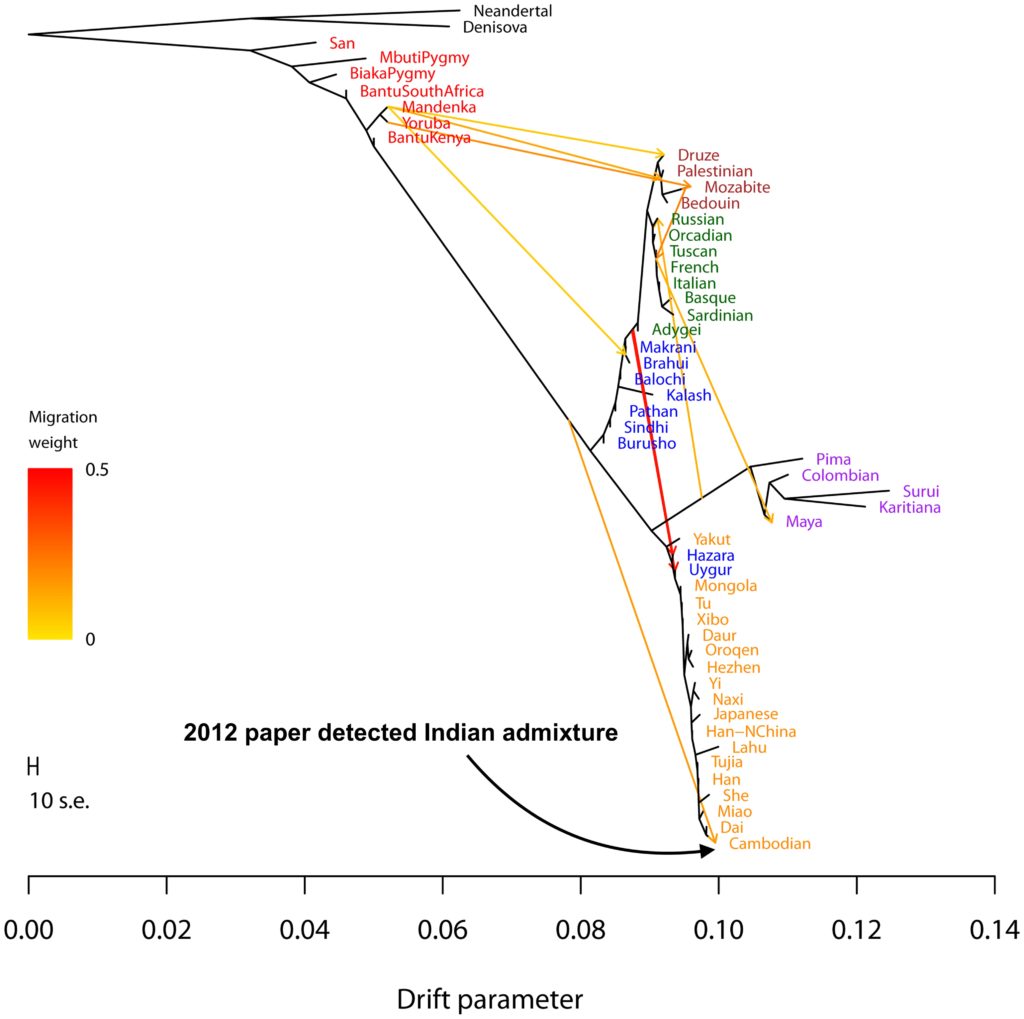Indian cultural influence is remarkable in present-day Mainland Southeast Asia (MSEA), and it may have stimulated early state formation in the region. Various present-day populations in MSEA harbor a low level of South Asian ancestry, but previous studies failed to detect such ancestry in any ancient individual from MSEA. In this study, we discovered a substantial level of South Asian admixture (ca. 40% – 50%) in a Protohistoric individual from the Vat Komnou cemetery at the Angkor Borei site in Cambodia. The location and direct radiocarbon dating result on the human bone (95% confidence interval is 78 – 234 calCE) indicate that this individual lived during the early period of Funan, one of the earliest states in MSEA, which shows that the South Asian gene flow to Cambodia started about a millennium earlier than indicated by previous published results of genetic dating relying on present-day populations. Plausible proxies for the South Asian ancestry source in this individual are present-day populations in Southern India, and the individual shares more genetic drift with present-day Cambodians than with most present-day East and Southeast Asian populations.
No surprise to readers of this weblog. South Asians obsess about possible admixture/contact with West Asia and Europe for obvious reasons, but it’s been pretty clear for a while that the “Indian cultural influence” on Southeast Asia was also demographic. Mainland Southeast Asia and the western part of Maritime Southeast Asia have minor but consistent levels of Indian ancestry. It showed up decades ago in Cambodian males who carried R1a Y haplogroup. And it showed up in a 2012 methods paper that detected gene flow from Pakistanis to Cambodians (no Indian samples in the dataset):
Genetics is basically done now. You can observe, for example, that lowland Thai populations have Indian ancestry, while highland tribes don’t have it.
We now know that the influence of Indian culture of a southern flavor to Southeast Asia was mediated by large numbers of humans. Indian genetic imprint on Burma can be chalked up to being Bengal’s neighbor, but you can’t say the same about Cambodia or Bali. Who were these people? Well, in a way, you could say that they were the “Brown Rajahs” for ancient Sarawak…

Mostly traders from South India and Bengal I assume. Also I wonder, why Hinduism was replaced by Buddhism in Southeast Asia around the time that Buddhism was declining in India itself?
I don’t think they tried using a Bengali source. But a South Indian sources were preferred over a North Indian source iirc.
Also if I am reading it right, the sample’s genetic affinity among modern Southeast Asians peaked among Kinh.
Are you sure ? I would expect the kinh to have the lowest affinity to any Indian group of all south East Asians.
They are the least Indic, most Sinic group in modern SE Asia.
They genocided the Cham who are more Indic shifted, and then I expect the Khmer to be even more Indic shifted than the Cham for various reasons (historical not genetic).
Check the full text option on biorxiv. f3(Mbuti; Cambodia PH 78-234 CE, X). Top 3 populations in the list are Kinh, Lahu and Cambodian.
South Indian history is underrated.
Early Cholas and Pandiyas totally owned the Eastern Seaboard as opposed to the Cheras who went West (Romans). Need a big effort to put the threads together.
Any thoughts on the pattern that Irula, Mala and Vellalar are the best matches?
These are populations that, particularly for Irula, match the end of the ANI-ASI cline with the Irula having almost no steppe ancestry.
I assume that what happened here is that the migrants into SE Asia came from Indo-Aryan groups who had moved very quickly into ASI zones and had very diluted steppe ancestry, with almost none of it.
A result very far removed from the idea of people who were genetically Ror / Brahmin like moving into the SE Asian coast.
i think the irula matches are probably artifactual cuz the cambodians have old southeast asian ancestral layers that are simulating them. the r1a % in Cambodia is like 5%. i think the were probably south indian, but from elite groups
1st-3rd century ce makes sense for departing Buddhist missionaries from Andhra into SEA, a time when various Buddhist schools of thought were still flourishing in South India. Amaravati and Nagarjunakonda have influenced stupa architecture of SEA such as Bagan in Myanmar and other parts of Cambodia
In this case I have heard that the yDNA was O and mtdna was R30. Where is R30 more common in South Asia today? An old 2005 paper gives high density in Gujarat but it also severely overestimates the age at 80,000+ years. Anyone has newer info on R30?
@Razib, it could be. In normal circumstances I doubt that would be hard to detect, as I think distinguishing between Hoabinhian and an ASI rich population shouldn’t be too hard – the offset of Iran_N/AASI would be very different; it should fit better as N_Indian+Onge, if there’s a Papuan related group in the pRight, something that is considerably off cline for India with steppe ancestry and AASI out of whack – but in this circumstance they aren’t getting very many SNPs out of this, so even simple tests could be hard.
I think there’s probably not much Hoabinhian, and it’s probably a group that was R1a rich, but very ASI admixed, to the extent that the R1a is kept but the steppe is mostly lost, like those samples from Bronze Age Spain that have something like 5-7% Yamnaya ancestry only ancestry but totally R1b.
If they can get more samples which are enriched enough to test it properly, I take my hat off to them.